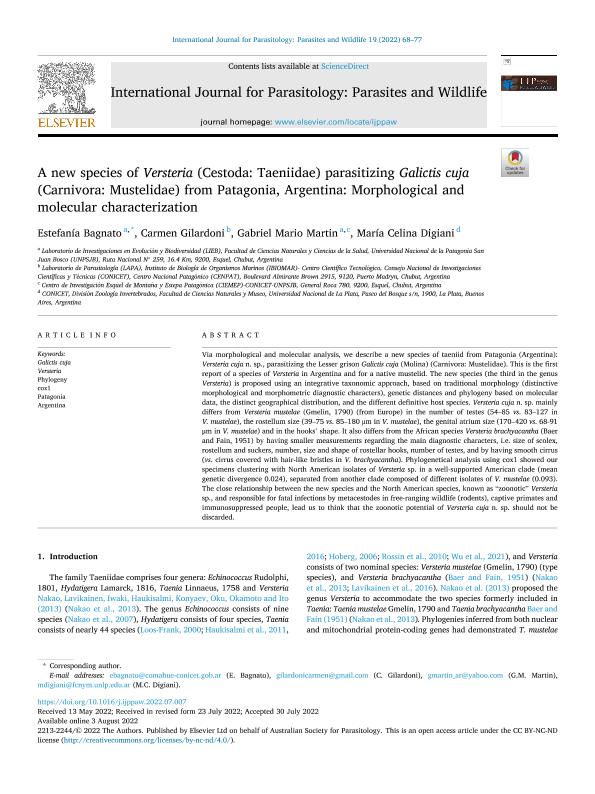Artículo
A new species of Versteria (Cestoda: Taeniidae) parasitizing Galictis cuja (Carnivora: Mustelidae) from Patagonia, Argentina: Morphological and molecular characterization
Fecha de publicación:
08/2022
Editorial:
Elsevier BV
Revista:
International Journal for Parasitology: Parasites and Wildlife
e-ISSN:
2213-2244
Idioma:
Inglés
Tipo de recurso:
Artículo publicado
Clasificación temática:
Resumen
Via morphological and molecular analysis, we describe a new species of taeniid from Patagonia (Argentina): Versteria cuja n. sp., parasitizing the Lesser grison Galictis cuja (Molina) (Carnivora: Mustelidae). This is the first report of a species of Versteria in Argentina and for a native mustelid. The new species (the third in the genus Versteria) is proposed using an integrative taxonomic approach, based on traditional morphology (distinctive morphological and morphometric diagnostic characters), genetic distances and phylogeny based on molecular data, the distinct geographical distribution, and the different definitive host species. Versteria cuja n. sp. mainly differs from Versteria mustelae (Gmelin, 1790) (from Europe) in the number of testes (54-85 vs. 83 in V. mustelae), the rostellum size (39-75 vs. 85-180 µm in V. mustelae), the genital atrium size (170-420 vs. 68-91 in V. mustelae) and in the hooks' shape. It also differs from the African species Versteria brachyacantha (Baer and Fain, 1951) by having smaller measurements regarding the main diagnostic characters, i.e. size of scolex, rostellum and suckers, number, size and shape of rostellar hooks, number of testes, and by having smooth cirrus (vs. cirrus covered with hair-like bristles in V. brachyacantha). Phylogenetical analysis using cox1 showed our specimens clustering with North American isolates of Versteria sp. in a well-supported American clade (mean genetic divergence 0.024), separated from another clade composed of different isolates of V. mustelae (0.093). The close relationship between the new species and the North American species, known as "zoonotic" Versteria sp., and responsible for fatal infections by metacestodes in free-ranging wildlife (rodents), captive primates and immunosuppressed people, lead us to think that the zoonotic potential of Versteria cuja n. sp. should not be discarded.
Palabras clave:
GALICTIS CUJA
,
VERSTERIA
,
PHYLOGENY
,
COX1
,
PATAGONIA
,
ARGENTINA
Archivos asociados
Licencia
Identificadores
Colecciones
Articulos(CCT - LA PLATA)
Articulos de CTRO.CIENTIFICO TECNOL.CONICET - LA PLATA
Articulos de CTRO.CIENTIFICO TECNOL.CONICET - LA PLATA
Articulos(CIEMEP)
Articulos de CENTRO DE INVESTIGACION ESQUEL DE MONTAÑA Y ESTEPA PATAGONICA
Articulos de CENTRO DE INVESTIGACION ESQUEL DE MONTAÑA Y ESTEPA PATAGONICA
Articulos(IBIOMAR)
Articulos de INSTITUTO DE BIOLOGIA DE ORGANISMOS MARINOS
Articulos de INSTITUTO DE BIOLOGIA DE ORGANISMOS MARINOS
Citación
Bagnato, Estefanía; Gilardoni, Carmen Mariangel; Martin, Gabriel Mario; Digiani, Maria Celina; A new species of Versteria (Cestoda: Taeniidae) parasitizing Galictis cuja (Carnivora: Mustelidae) from Patagonia, Argentina: Morphological and molecular characterization; Elsevier BV; International Journal for Parasitology: Parasites and Wildlife; 19; 8-2022; 68-77
Compartir




